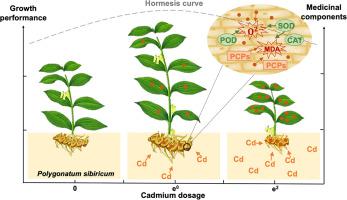Ecotoxicology and Environmental Safety ( IF 6.2 ) Pub Date : 2021-09-09 , DOI: 10.1016/j.ecoenv.2021.112724 Xie Mengdi 1 , Chen Wenqing 2 , Dai Haibo 3 , Wang Xiaoqing 3 , Yang Li 3 , Kang Yuchen 3 , Sun Hui 3 , Wang Lei 1

|
Compared to other soil remediation technologies, Cd-contaminated farmland soil with low cadmium accumulation (LCA) plant-based safe utilization is more catered to developing countries with food in high demand. Hormesis, which describes the fortification of plant growth performance by a low level of environmental stress, can be innovatively used to achieve increases in crop yield and plant functional components, thus amplifying the safe utilization efficiency of low Cd-contaminated soil by LCA plants. In the present study, the growth and physiological responses of Polygonatum sibiricum, a traditional Chinese medicinal herb, were investigated under laboratory conditions of gradient Cd dosage concentrations and times. As a result, the growth performance of P. sibiricum reached the peak of an inverse U-shaped curve of hormesis under e0 mg kg−1 and 9 months of Cd stress, with elevations in tuber biomass (medicinal part), plant height and polysaccharide content (medicinal components) of 143%, 25% and 90%, respectively. Meanwhile, trace Cd accumulation (0.41 mg kg−1) in the tuber guaranteed medicinal edible safety. In addition, Cd-induced hormesis in P. sibiricum was verified to be overcompensated by antioxidation systems. In conclusion, such ‘win-win’ results, including low Cd accumulation and enhancement of plant pharmaceutical value, provided medicinal herbs with a possibility for safe soil utilization.











































 京公网安备 11010802027423号
京公网安备 11010802027423号